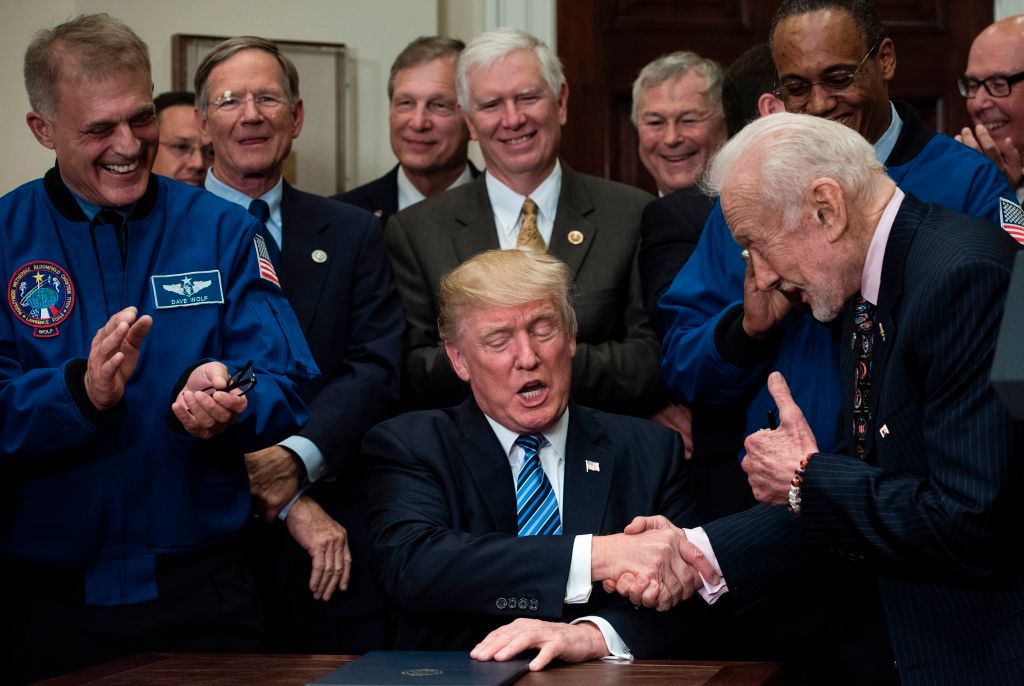
For decades, NASA has been the kid politely asking for a raise in its allowance. Time was NASA’s pocket money was huge. Go back 54 years, to 1966, and the space agency was getting $5.9 billion a year—which would be a tidy $47 billion in 2020 dollars. That represented 4.1% of America’s annual household budget. But in 1966 there was also a bully on the block, whose mailbox at the time read “the Union of Soviet Socialist Republics.” They were racing the U.S. to be the first to leave the block altogether and fly to the moon, so the States were willing to spend whatever amount of money it took to beat them there.
Then, in 1969, the U.S. did beat them. And that’s when NASA’s allowance began to crash, dropping to $4.2 billion that year, or just 2.3% of the family budget; to $3.2 billion in 1974 (1.2% of the budget), and on down from there. In the current fiscal year, the space agency’s $22.629 billion budget represented just 0.48% of annual federal outlays.
But now comes a bump. The scientific community has made no secret of the fact that it finds little to love in the Trump Administration—especially in its rollback of environmental protections. But President Trump has been a champion of space. For example, he revived the National Space Council in 2017, putting back in play a presidential advisory group that had existed intermittently from 1958 to 1973, then again from 1989 to 1993, and often had an influential role in keeping space exploration a priority item for presidents who often felt they had more immediate needs to address. And Trump’s Space Force has made a lot of headlines—even if it will likely amount to little more than a new flag, a new insignia and a lot of money wasted on bureaucracy, with the work the ostensible sixth branch of the military will be doing already being handled perfectly well by the Air Force.
But when it comes to the idea of returning Americans to the moon, the Trump Administration does appear to be delivering on a popular promise: laying down a 2024 marker for NASA. The space agency has embraced the challenge, promising that sometime that year the country will land “the first woman and the next man on the moon.” The first-woman piece is a significant (and very worthy) part of NASA’s marketing campaign and the program itself is appropriately named Artemis, after the sister of Apollo.
The budget has crept up accordingly over the past three years, and last week the White House announced that it would be asking Congress for another NASA raise in 2021, with the budget increasing 12% to $25.2 billion. The lion’s share of the new funding is earmarked for Artemis.
For space enthusiasts, this is the rare story out of Washington that is all good news. NASA’s heavy-lift rocket, the blandly named Space Launch System (SLS), has been in start-stop development for a preposterously long 14 years, hamstrung by flat budgets and ever-changing policies from ever-changing Administrations. (By contrast, it took NASA little more than four years to invent and build the Saturn V rocket, launching the first one in 1967 and a dozen more by 1973.) At last, however, the SLS is close to completion, as is the Orion spacecraft—the Artemis version of the Apollo orbiter. The lunar landing vehicle is less far-along, but the new cash infusion will help and while NASA has not yet chosen a private contractor to design and build the spacecraft, the smart money is on Blue Moon, a lander that is already nearly four years into development by Blue Origin, the space company established by Amazon founder Jeff Bezos.
Whether NASA can actually stick a lunar landing by 2024 is not remotely a sure thing—not least because a presidential election is just nine months away and a change in administrations could mean yet another change in NASA policy. But a return to the moon has popular appeal, a woman on the moon has even more, and with the lunar hardware so close to completion, mothballing it due to budget fights or politics would be an embarrassment on both ends of Pennsylvania Avenue.
Indeed, politics can actually help ensure Artemis’s future—thanks in large part to the electoral map. Florida, remains the swingiest of swing states and Texas is trending purple. Between them they have 67 electoral votes, or nearly 25% of the total needed for victory. Would you like to be the presidential candidate telling the good folks of Houston and Cape Canaveral that their moon dreams have to be shelved again?
It takes smarts, brass and courage to get to the moon. But it takes money too. At this point, NASA’s funding—while still modest by 1960s standards—could be just enough to put the moon mission over the top.
A version of this article was originally published in TIME’s Space newsletter. Click here to sign up to receive these stories early.
More Must-Reads from TIME
- Donald Trump Is TIME's 2024 Person of the Year
- TIME’s Top 10 Photos of 2024
- Why Gen Z Is Drinking Less
- The Best Movies About Cooking
- Why Is Anxiety Worse at Night?
- A Head-to-Toe Guide to Treating Dry Skin
- Why Street Cats Are Taking Over Urban Neighborhoods
- Column: Jimmy Carter’s Global Legacy Was Moral Clarity
Write to Jeffrey Kluger at jeffrey.kluger@time.com